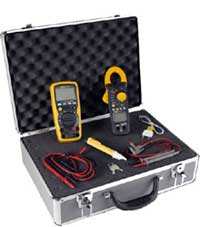 When a device is reported as faulty, the person taking the call should ask for details of the device, whether the device has
When a device is reported as faulty, the person taking the call should ask for details of the device, whether the device has
This should then be logged into the inventory management system and the job allocated to the appropriate technician. Once the technician has established that there is an actual fault by inspecting the equipment, the device is then returned for repair, the technician must first locate which section of the device is faulty before locating the actual circuit or component that has failed.
There are recognised methods used to narrow down the fault to one area, but before these are discussed, it is useful to consider some fairly obvious but often overlooked points:
The technician must have a maintenance manual for the device with an up-to-date circuit description and diagram. This manual should also give the figures of the performance specification to allow verification of the device calibration once it is repaired.
The technician must have all the necessary test equipment, which must be calibrated, and calibration records held for future inspection.
Usually a list of test equipment required, and any special tools / instructions listed in the maintenance manual.
The technician then has to define the fault accurately. This point is most important. It is no good trying to locate a fault that is vaguely defined. The symptoms must be accurately noted when speaking to the clinical user, and this means that a functional test must be made on the instrument in accordance with the parameters described by the clinical user.
For example consider that a cardiac monitor has been returned for repair with a suspect power supply failure. Before taking off the cover and checking the power supply voltages, the technician would:
- Check the mains supply to the cardiac monitor from the electrical plug socket
- Check any other functions (mains indicators, rear on/off switch, etc.)
- Check the mains cable.
- Check that the mains fuses are not blown.
- Make notes of the fault symptoms.
If the monitor has no functionality after the above checks, the power supply should be the first set of checks.
The complete circuit of most medical electronic equipment can be broken down into a series of functional blocks. By treating the instrument in blocks, rather than as a whole, it is possible to narrow down the search for a faulty circuit or component, first of all to one block, then by measurements within that block to locate the actual faulty circuit board or component.
The methods used to decide which block is faulty are:
- Input to output
- Output to input
- Half-split
The INPUT TO OUTPUT & OUTPUT TO INPUT methods are examples of a systematic approach.
The method involves applying a suitable input signal (if required) into the input block (i.e. connect the mains supply to the monitor input). Measurements are then made sequentially at the output of each block in turn (i.e. check secondary voltage on transformer or output of the switch mode power supply), working either from the input towards the output or from the output back to the input, until the faulty block is located. This logical method is the one most service technicians use on equipment containing a limited number of blocks.
The HALF-SPLIT method is very powerful in locating faults in medical devices made up of a large number of blocks in series. Take for example an X-Ray unit. Since there are many blocks it is possible to divide the circuit in half, test that half, decide which half is working correctly, then split the non-functioning section into half again to locate the fault.
An example is the best way of understanding the method.
Assume that a fault exists in the exposure timing circuit of the unit which has 8 circuit blocks, the sequence of tests would be as follows:
Input » (Circuit1) - Circuit2 - Circuit3 - (Circuit4) » Half Split Point » Circuit5 - (Circuit6) - Circuit7 - Circuit8

Split the signal path from the radiographic control panel switch to the timer relay in half, inject signal using the hand switch into the input of the circuit (Circuit 1), and check output at the half split point (Circuit 4). Output correct.
- Therefore the fault is somewhere between blocks (Circuit 5) to (Circuit 8).
- Split blocks (Circuit 5) to (Circuit 8) in half by checking output of (Circuit 6). [Input signal can be left at (Circuit 1)] No output.
- Leaving signal at (Circuit 1), check output from (Circuit 5). Output correct.
- Indicating that the faulty block is (Circuit 6).
The half-split method can reduce substantially the number of tests necessary to locate a fault when the number of components or blocks in series is very large.
As equipment circuit boards become more densely packed with multi-layered miniaturised components, it is important to recognise that we must consider the reality of whether a device can be repaired economically.
It is important to understand the amortised value of a device, and the value of the time required to repair the device, before carrying out the repair. If the amortised value of the device is worth less than the cost of the repair, the manager should decide whether the repair is still justified.

No comments:
Post a Comment